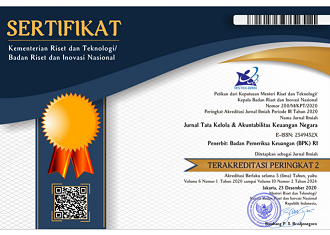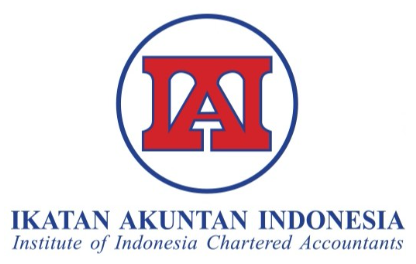The impact of risk management implementation on the effectiveness of SAI’s internal audit function
DOI:
https://doi.org/10.28986/jtaken.v10i2.1614Keywords:
policy implementation, internal audit, effectivenessAbstract
Internal audits play an important role in monitoring the achievement of organizational objectives. However, research on the factors influencing the success of internal audits remains limited. This study aims to investigate the effectiveness of BPK’s Itama (The Inspectorate General of the Audit Board of the Republic of Indonesia) functions, hypothesized to be influenced by risk management policy implementation. This study employs quantitative methods; data were collected via surveys and analyzed using structural equation modeling (SEM) to test theory-based hypotheses. Results reveal a significant positive correlation between risk management policy implementation and the effective functioning of Itama. Additionally, the study identifies key factors determining the success of risk management policy implementation: economic, social, and political conditions. Therefore, internal auditors of supreme audit institutions must consider these external factors when implementing risk management policies. This study contributes to understanding internal audit effectiveness by highlighting the impact of external economic, social, and political conditions.
References
Abdelrahim, A., & Al-Malkawi, H.-A. N. (2022). The influential factors of internal audit effectiveness: A conceptual model. International Journal of Financial Studies, 10(3). https://doi.org/10.3390/ijfs10030071
Abuzarqa, R. (2019). The relationship between organizational culture, risk management and organizational performance. Cross-Cultural Management Journal, XXI, 13–20.
Aikins, S. K. (2011). An examination of government internal audits’ role in improving financial performance. Public Finance and Management, 11(4), 306–337.
Alzeban, A. (2015). The impact of culture on the quality of internal audit: An empirical study. Journal of Accounting, Auditing & Finance, 30(1), 57–77.
Alzeban, A., & Gwilliam, D. (2014). Factors affecting the internal audit effectiveness: A survey of the Saudi public sector. Journal of International Accounting, Auditing and Taxation, 23(2), 74–86. https://doi.org/10.1016/J.INTACCAUDTAX.2014.06.001
Arena, M., & Azzone, G. (2009). Identifying organizational drivers of internal audit effectiveness. International Journal of Auditing, 13(1), 43–60. https://doi.org/https://doi.org/10.1111/j.1099-1123.2008.00392.x
BPK. (2019). Peraturan Badan Pemeriksa Keuangan Nomor 1 Tahun 2019 tentang Organisasi dan Tata Kerja Pelaksana Badan Pemeriksa Keuangan. https://peraturan.bpk.go.id/Details/105929/peraturan-bpk-no-1-tahun-2019
BPK. (2024). Peraturan Badan Pemeriksa Keuangan Republik Indonesia Nomor 1 Tahun 2024 tentang Perubahan Keempat atas Peraturan Badan Pemeriksa Keuangan Nomor 1 Tahun 2019 tentang Organisasi dan Tata Kerja Pelaksana Badan Pemeriksa Keuangan. https://peraturan.bpk.go.id/Details/277682/peraturan-bpk-no-1-tahun-2024
Brown, M. P., Bezo, L., & Nanivska, V. (2013). Building policy capacity at the Ukrainian centre: The policy units project. Canadian Public Administration, 56(3), 433–455. https://doi.org/https://doi.org/10.1111/capa.12029
Carvalho, M., & Junior, R. (2015). Impact of risk management on project performance: The importance of soft skills. International Journal of Production Research, 53, 321–340. https://doi.org/10.1080/00207543.2014.919423
Chase, G. (1979). Implementing a human services program: How hard will it be? Public Policy, 27(4), 385–435. http://europepmc.org/abstract/MED/10297622
Coetzee, P. (2016). Contribution of internal auditing to risk management. International Journal of Public Sector Management, 29(4), 348–364. https://doi.org/10.1108/IJPSM-12-2015-0215
Coetzee, P., & Erasmus, L. J. (2017). What drives and measures public sector internal audit effectiveness? Dependent and independent variables. International Journal of Auditing, 21(3), 237–248. https://doi.org/https://doi.org/10.1111/ijau.12097
Coetzee, P., & Lubbe, D. (2014). Improving the efficiency and effectiveness of risk‐based internal audit engagements. International Journal of Auditing, 18(2), 115–125.
Daft, R. L. (2021). Organization theory and design (Thirteenth). Cengage Learning Canada Inc.
de Zwaan, L., Stewart, J., & Subramaniam, N. (2011). Internal audit involvement in enterprise risk management. Managerial Auditing Journal, 26(7), 586–604. https://doi.org/10.1108/02686901111151323
Dewi, N. P. J., & Oktamianti, P. (2019). Policy analysis of occupational health implementation at R. Syamsudin, SH. Hospital, Sukabumi, West Java. The International Conference on Public Health Proceeding, 4(01), 122.
Djohanis, H., Mustainah, M., & Nasir, N. (2024). Implementasi kebijakan penjualan liquifeid petroleum gas tabung 3 kilogram sesuai harga eceran tertinggi (Studi di Kecamatan Luwuk Selatan Kabupaten Banggai). Jurnal Ilmiah Research Student, 1(4), 208–222.
Duadji, N. (2019). Analisis program indonesia sehat dengan pendekatan keluarga di Kecamatan Gadingrejo Kabupaten Pringsewu. Administrativa: Jurnal Birokrasi, Kebijakan Dan Pelayanan Publik, 1(1), 63–73.
Endaya, K. A., & Hanefah, M. M. (2016). Internal auditor characteristics, internal audit effectiveness, and moderating effect of senior management. Journal of Economic and Administrative Sciences, 32(2), 160–176. https://doi.org/10.1108/JEAS-07-2015-0023
Erasmus, L., & Coetzee, P. (2018). Drivers of stakeholders’ view of internal audit effectiveness. Managerial Auditing Journal, 33(1), 90–114. https://doi.org/10.1108/MAJ-05-2017-1558
Firdausi, F. A., Putera, R. E., & Yoserizal, Y. (2023). Implementasi program jaminan sosial ketenagakerjaan bagi tenaga kerja bukan penerima upah di BPJS Ketenagakerjaan Padang. Journal of Social and Policy Issues, 3(4), 183–191. https://doi.org/10.58835/jspi.v3i4.212
Fornell, C., & Larcker, D. F. (1981). Evaluating structural equation models with unobservable variables and measurement error. Journal of Marketing Research, 18(1), 39–50. https://doi.org/10.2307/3151312
Gordon, L. A., Loeb, M. P., & Tseng, C.-Y. (2009). Enterprise risk management and firm performance: A contingency perspective. Journal of Accounting and Public Policy, 28(4), 301–327. https://doi.org/10.1016/j.jaccpubpol.2009.06.006
Görener, A. (2017). Risk based internal audit. In H. Dinçer & Ü. Hacioğlu (Eds.), Risk management, strategic thinking and leadership in the financial services industry: A proactive approach to strategic thinking (pp. 261–275). Springer International Publishing. https://doi.org/10.1007/978-3-319-47172-3_17
Grindles, M. S. (1980). Politics and policy implementation in the third world. Princeton University Press.
Hair, J. F., Black, W. C., Babin, B. J., & Anderson, R. E. (2010). Multivariate data analysis: A global perspective. Pearson Education.
Hill, M., & Hupe, P. (2002). Implementing public policy: Governance in theory and in practice. SAGE Publications Ltd.
Hogwood, B., & Gunn, L. (2014). Why “perfect implementation” is unattainable. In M. Hill (Ed.), Policy process (pp. 217–225). Routledge.
Howlett, M. (2018). Moving policy implementation theory forward: A multiple streams/critical juncture approach. Public Policy and Administration, 34(4), 405–430. https://doi.org/10.1177/0952076718775791
Howlett, M., & Cashore, B. (2014). Conceptualizing public policy. In I. Engeli & C. R. Allison (Eds.), Comparative policy studies: conceptual and methodological challenges (pp. 17–33). Palgrave Macmillan UK. https://doi.org/10.1057/9781137314154_2
Howlett, M., Ramesh, M., & Wu, X. (2015). Understanding the persistence of policy failures: The role of politics, governance and uncertainty. Public Policy and Administration, 30(3–4), 209–220. https://doi.org/10.1177/0952076715593139
IDI. (2023). Risk management for supreme audit institutions. https://www.idi.no/de/elibrary/well-governed-sais/crisp/1912-crisp-risk-management-quick-reference-guide-en/file
IIA. (2009). IIA Position Paper: The role of internal auditing in enterprise-wide risk management, https://www.theiia.org/globalassets/documents/resources/the-role-of-internal-auditing-in-enterprise-wide-risk-management-january-2009/pp-the-role-of-internal-auditing-in-enterprise-risk-management.pdf
IIA. (2018). IIA Position Paper: Internal Auditing’s role in corporate governance. https://www.theiia.org/globalassets/documents/resources/internal-auditings-role-in-corporate-governance-may-2018/internal-auditings-role-in-corporate-governance.pdf
IIA. (2020). The IIA’s three lines model: An update of the three lines of defense. https://www.theiia.org/globalassets/documents/resources/the-iias-three-lines-model-an-update-of-the-three-lines-of-defense-july-2020/three-lines-model-updated-english.pdf
INTOSAI. (2019). ISSAI 300: Performance audit principles. INTOSAI. https://www.intosai.org/fileadmin/downloads/documents/open_access/ISSAI_100_to_400/issai_300/ISSAI_300_en_2019.pdf
Kpodo, B., & Agyekum, K. (2015). The effects of risk culture on organizational performance -The cases of some selected financial institutions in Ghana. International Journal of Science And Research, 4(12), 5–611. https://doi.org/10.21275/v4i12.nov152020
Lenz, R., & Hahn, U. (2015). A synthesis of empirical internal audit effectiveness literature pointing to new research opportunities. Managerial Auditing Journal, 30(1), 5–33. https://doi.org/10.1108/MAJ-08-2014-1072
Leong, C., & Howlett, M. (2022). Policy learning, policy failure, and the mitigation of policy risks: Re-thinking the lessons of policy success and failure. Administration & Society, 54(7), 1379–1401.
Liando, D. M. (2013). The influence of population administrative policy implementation on the quality of ID card service. Bisnis & Birokrasi: Jurnal Ilmu Administrasi Dan Organisasi, 19(2). https://doi.org/10.20476/jbb.v19i2.1885
Makinde, T. (2005). Problems of policy implementation in developing nations: The Nigerian experience. Journal of Social Sciences, 11(1), 63–69. https://doi.org/10.1080/09718923.2005.11892495
Martz, W. (2013). Evaluating organizational performance: Rational, natural, and open system models. American Journal of Evaluation, 34(3), 385–401. https://doi.org/10.1177/1098214013479151
May, P. J. (2014). Implementation failures revisited: Policy regime perspectives. Public Policy and Administration, 30(3–4), 277–299. https://doi.org/10.1177/0952076714561505
McConnell, A. (2010a). Policy success, policy failure and grey areas in-between. Journal of Public Policy, 30(3), 345–362. https://doi.org/DOI: 10.1017/S0143814X10000152
McConnell, A. (2010b). Understanding policy success: Rethinking public policy. Bloomsbury Publishing.
McConnell, A. (2015). What is policy failure? A primer to help navigate the maze. Public Policy and Administration, 30(3–4), 221–242. https://doi.org/10.1177/0952076714565416
Politis, Y. (2018). A risk-based internal audit approach for the public sector: Evidence from Greece. International Journal of Auditing Technology, 4(1), 16–35. https://doi.org/10.1504/IJAUDIT.2018.100192
Pülzl, H., & Treib, O. (2017). Implementing public policy. In F. Fischer, G. J. Miller & M. S. Sidney (Eds.), Handbook of public policy analysis: Theory, politics, and methods (pp. 115–134). Routledge.
Rahmasari, A., & Setiawan, D. (2022). Maturity of internal control system, the capability of internal auditors, and performance accountability in local governments. Jurnal Tata Kelola Dan Akuntabilitas Keuangan Negara, 8(2), 159–176. https://doi.org/10.28986/jtaken.v8i2.830
Roussy, M., Barbe, O., & Raimbault, S. (2020). Internal audit: from effectiveness to organizational significance. Managerial Auditing Journal, 35(2), 322–342. https://doi.org/10.1108/MAJ-01-2019-2162
Sari, P. K., & Sujianto, S. (2021). Implementasi Peraturan Gubernur Sumatera Barat Tentang Penggunaan Alat dan Bahan Penangkapan Ikan di Perairan Danau Singkarak. Journal of Social and Policy Issues, 1(3), 104–109. https://doi.org/10.58835/jspi.v1i3.27
Sharma, N., & Singh, R. K. (2019). A unified model of organizational effectiveness. Journal of Organizational Effectiveness: People and Performance, 6(2), 114–128. https://doi.org/10.1108/JOEPP-10-2018-0084
Shet, S. V, Patil, S. V, & Chandawarkar, M. R. (2019). Competency based superior performance and organizational effectiveness. International Journal of Productivity and Performance Management, 68(4), 753–773. https://doi.org/10.1108/IJPPM-03-2018-0128
Smith, T. B. (1973). The policy implementation process. Policy Sciences, 4(2), 197–209. https://doi.org/10.1007/BF01405732
Steers, R. M. (1975). Problems in the measurement of organizational effectiveness. Administrative Science Quarterly, 20(4), 546–558. https://doi.org/10.2307/2392022
Steers, R. M. (1976). When is an organization effective? A process approacht to understanding effectiveness. Organizational Dynamics, 5(2), 50–63. https://doi.org/10.1016/0090-2616(76)90054-1
The International Organization for Standardization. (2018). ISO 31000:2018 - Risk management. https://www.iso.org/standard/65694.html
Thomya, W., & Saenchaiyathon, K. (2015). The effects of organizational culture and enterprise risk management on organizational performance: A conceptual framework. International Business Management, 9(2), 158–163.
Tummers, L., Steijn, B., & Bekkers, V. (2012). Explaining the willingness of public professionals to implement public policies: Content, context, and personality characteristics. Public Administration, 90(3), 716–736. https://doi.org/https://doi.org/10.1111/j.1467-9299.2011.02016.x
Turetken, O., Jethefer, S., & Ozkan, B. (2020). Internal audit effectiveness: Operationalization and influencing factors. Managerial Auditing Journal, 35(2), 238–271. https://doi.org/10.1108/MAJ-08-2018-1980
Van Meter, D. S., & Van Horn, C. E. (1975). The policy implementation process: A conceptual framework. Administration & Society, 6(4), 445–488. https://doi.org/10.1177/009539977500600404
Vecchiato, R. (2017). Disruptive innovation, managerial cognition, and technology competition outcomes. Technological Forecasting and Social Change, 116, 116–128. https://doi.org/10.1016/j.techfore.2016.10.068
Wu, X., Ramesh, M., & Howlett, M. (2015). Policy capacity: A conceptual framework for understanding policy competences and capabilities. Policy and Society, 34(3–4), 165–171. https://doi.org/10.1016/j.polsoc.2015.09.001
Xue, B., Cen, J., Liu, B., Qian, L., & Yuan, J. (2022). How does policy implementation affect the sustainability of public–private partnership projects? A stakeholder-based framework. Public Performance & Management Review, 45(5), 1029–1065. https://doi.org/10.1080/15309576.2022.2107029
Yang, K., Dimeo, P., & Winand, M. (2022). Anti-doping in China: An analysis of the policy implementation processes through stakeholders’ perspectives. Sport Management Review, 25(2), 360–381. https://doi.org/10.1080/14413523.2021.1917247
Zeelen, J., Rampedi, M., & de Jong, G. (2011). Adult education in the Limpopo province of South Africa: challenges for policy implementation. International Journal of Lifelong Education, 30(3), 385–402. https://doi.org/10.1080/02601370.2011.570874
Downloads
Submitted
Accepted
Published
How to Cite
Issue
Section
License
Copyright (c) 2024 Jurnal Tata Kelola dan Akuntabilitas Keuangan Negara

This work is licensed under a Creative Commons Attribution-ShareAlike 4.0 International License.

Jurnal Tata Kelola dan Akuntabilitas Keuangan Negara is licensed under
a Creative Commons Attribution-ShareAlike 4.0 International License





















